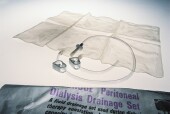Dialysis Catheter Placement Makes Little Difference in Infection Risk
Neck, leg sites similar, but jugular should be choice for patients with higher BMI
|
E-mail this article
Subscribe to news
Printer friendly version
|

(SOURCE: Journal of the American Medical Association, news release, May 27, 2008)
TUESDAY, May 27 (HealthDay News) -- There's little overall difference in infection risk if a catheter for dialysis is inserted into a neck vein or an upper leg vein in critically ill patients, French researchers report.
Currently, it's widely believed the neck catheter is less likely to cause infection than the leg catheter.
The researchers compared rates of bacteria growth on catheters (catheter colonization) at the time of their removal and rates of catheter-related blood stream infections among 750 severely ill patients in intensive care units who required catheter insertion for dialysis. The patients were randomly selected to have the catheter inserted in the neck (jugular) vein or the leg (femoral) vein.
Catheter colonization occurred at a rate of 40.8 per 1,000 catheter-days among patients in the femoral group and a rate of 35.7 per 1,000 catheter-days among those in the jugular group. Catheter-related bloodstream infection occurred in three of 324 (0.9 percent) of patients in the femoral group and in five of 313 (1.6) percent of patients in the jugular group. This was not a statistically significant difference.
The study authors said the findings are "inconsistent with the widely accepted convention to avoid femoral catheterization to prevent the risk of catheter-related infection."
They did find that hematoma formation (localized area of bleeding beneath the skin) was significantly higher in the jugular group (3.6 percent) than in the femoral group (1.1 percent).
The researchers also found that people with a body-mass index (BMI) of less than 24.2 had twice the risk of catheter colonization when given a jugular catheter than when given a femoral catheter. But patients with a BMI greater than 28.4 were 60 percent less likely to develop catheter colonization when given a jugular catheter than when given a femoral catheter.
"In conclusion, the decision for the best site of insertion to prevent complications might be more complex than previously suggested. Our results support the current guideline for preventing catheter complications regarding the optimal site for catheter insertion in the ICU. If a subclavian approach is not available, and the individual risk of complications between the jugular and femoral sites is equal, the jugular site should be strongly considered for patients with higher BMI. We suggest that first-choice careful femoral catheterization by an experienced operator with full sterile precautions and appropriate post-insertion site care in non-obese, bed-bound, severely ill patients is acceptable and could reduce catheter-related morbidity compared with jugular catheterization," the researchers wrote.
The study is published in the May 28 issue of the Journal of the American Medical Association.
More information
The National Kidney Foundation has more about dialysis catheters. 
Copyright © 2008 ScoutNews, LLC. All rights reserved. 
HealthDayNews articles are derived from various sources and do not reflect federal policy. healthfinder.gov does not endorse opinions, products, or services that may appear in news stories. For more information on health topics in the news, visit the healthfinder.gov health library.